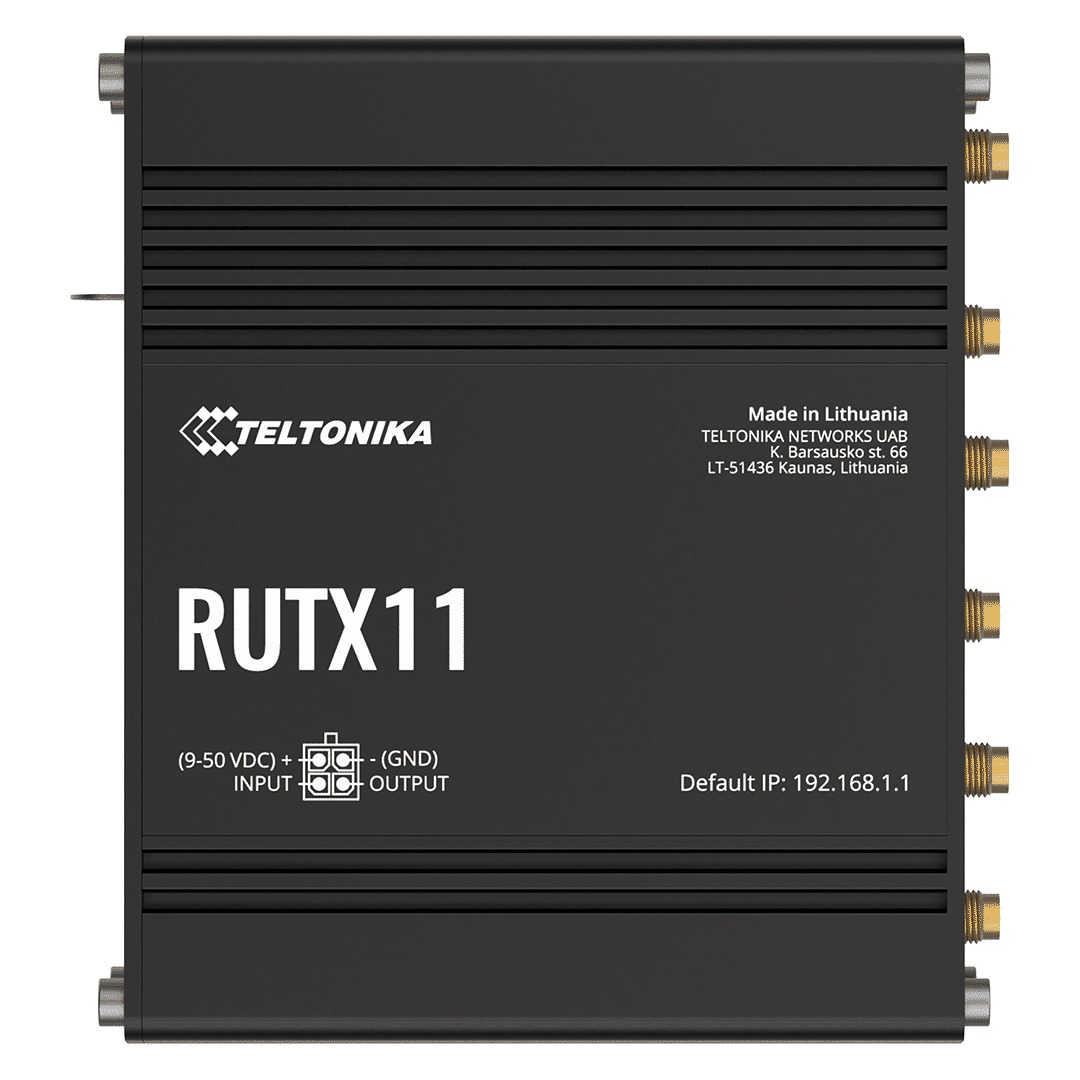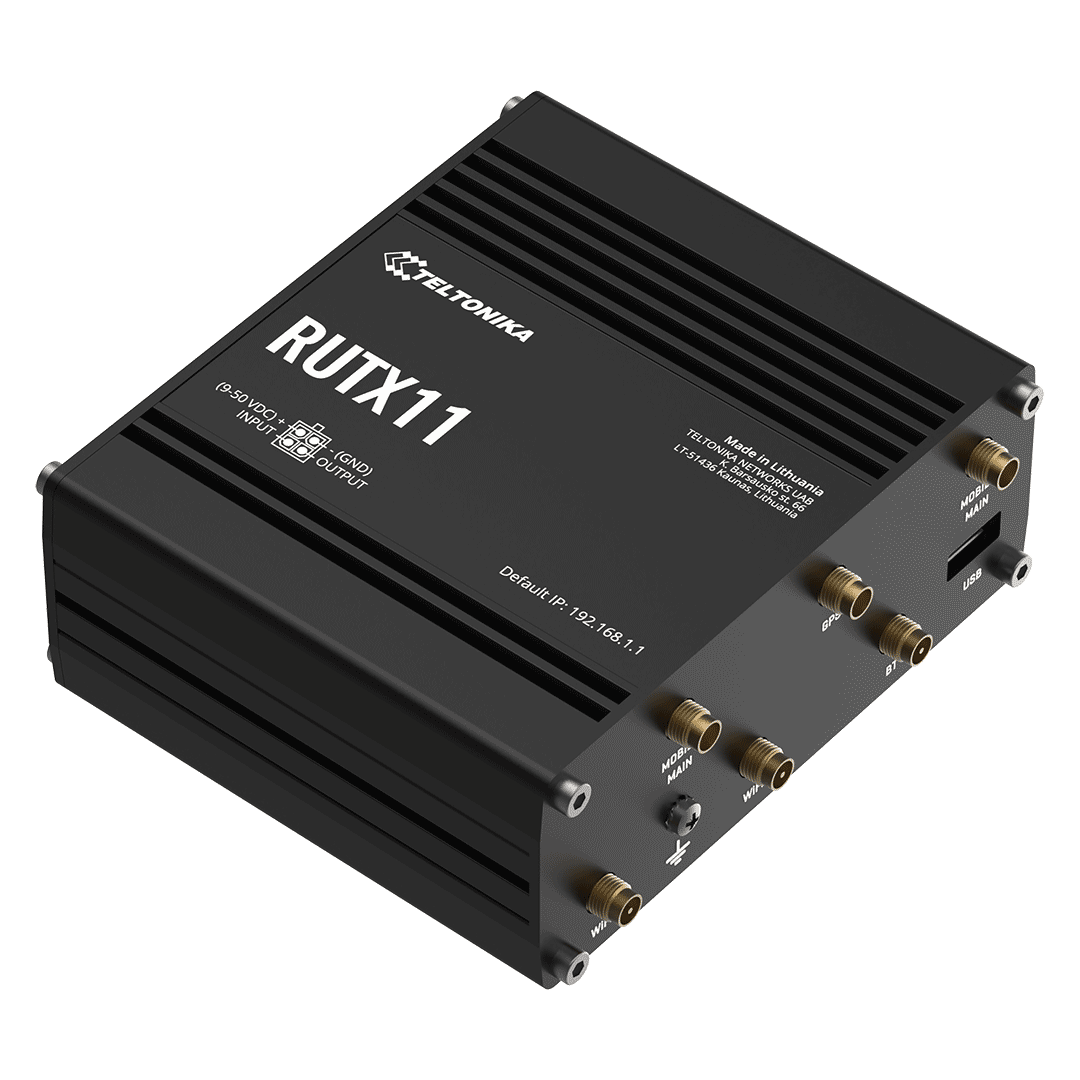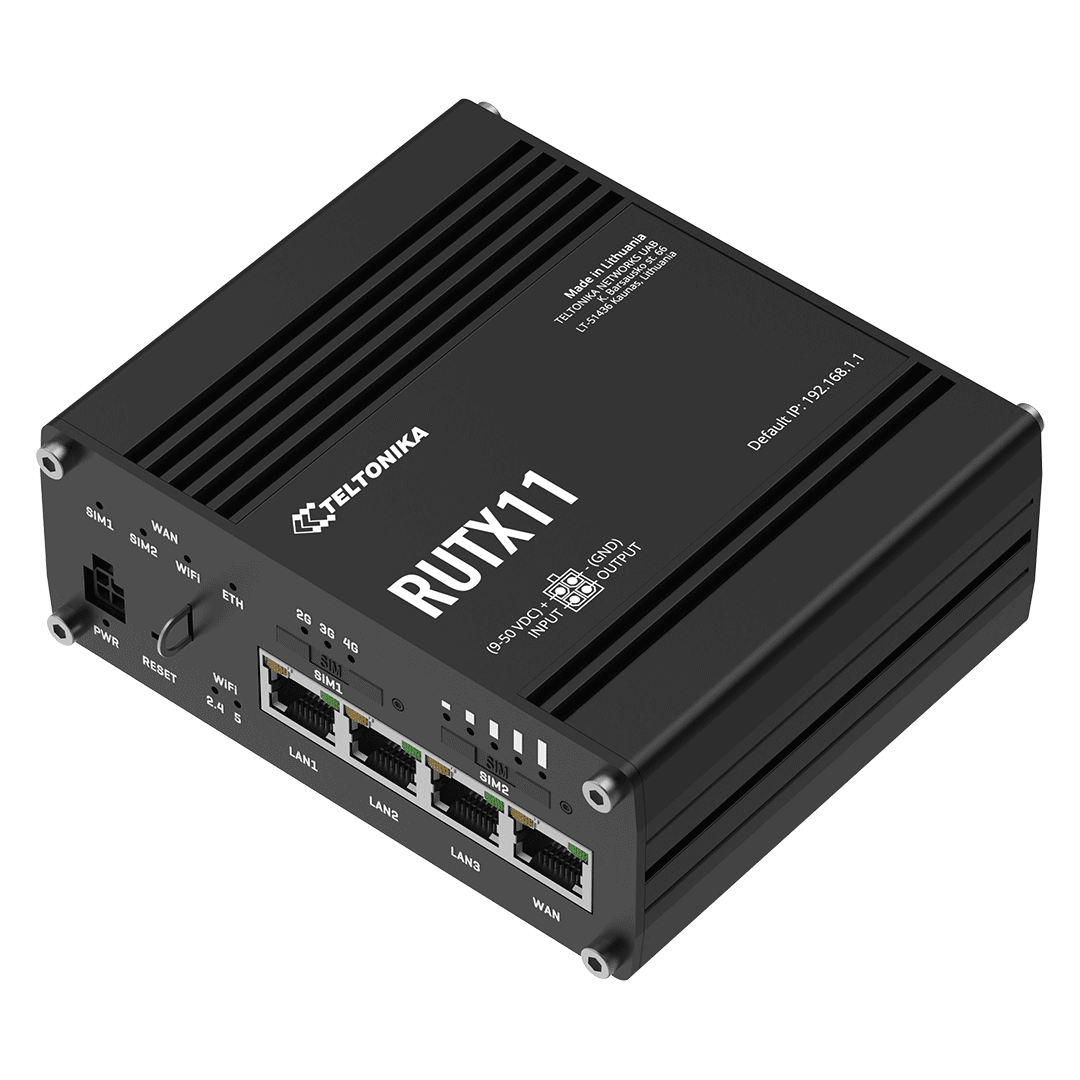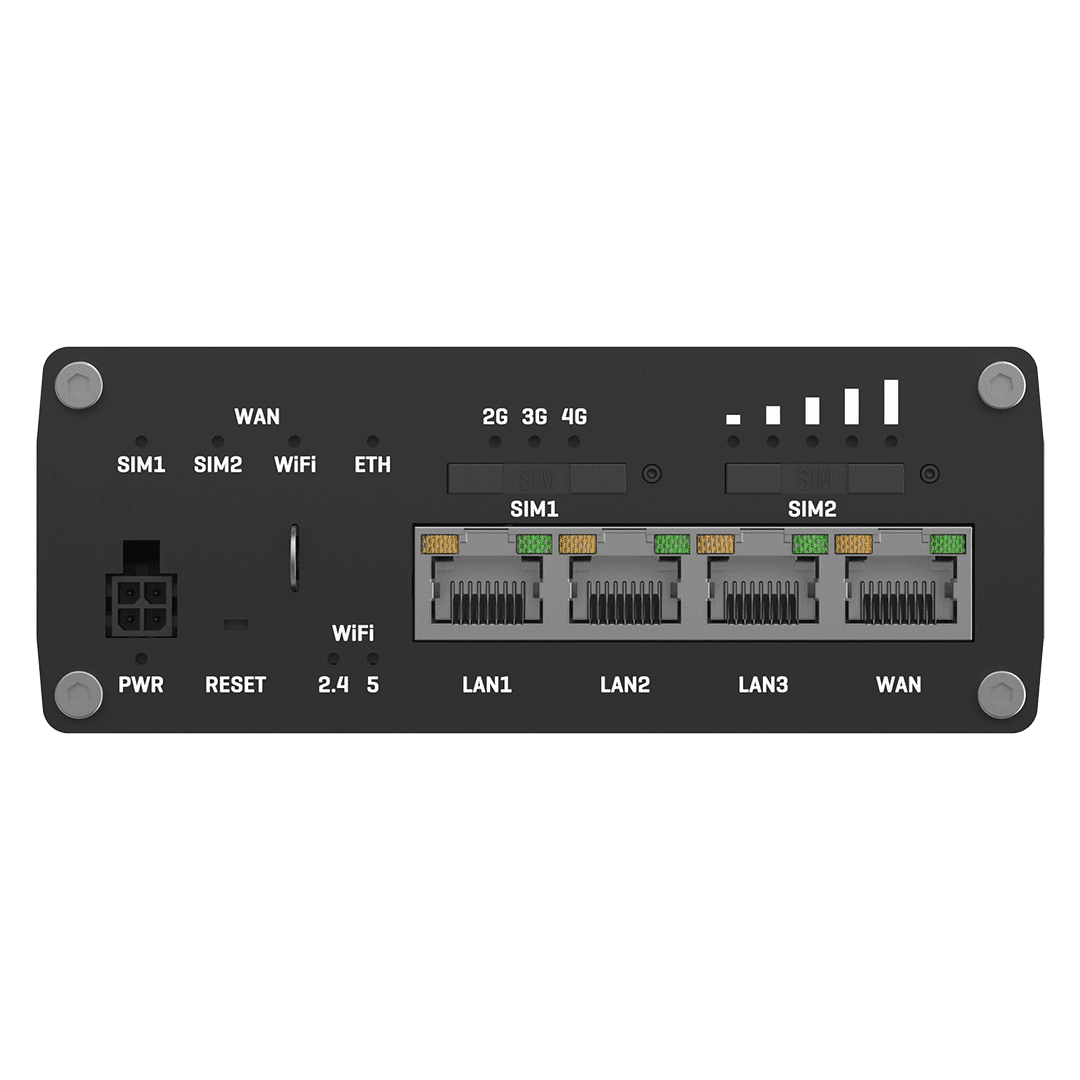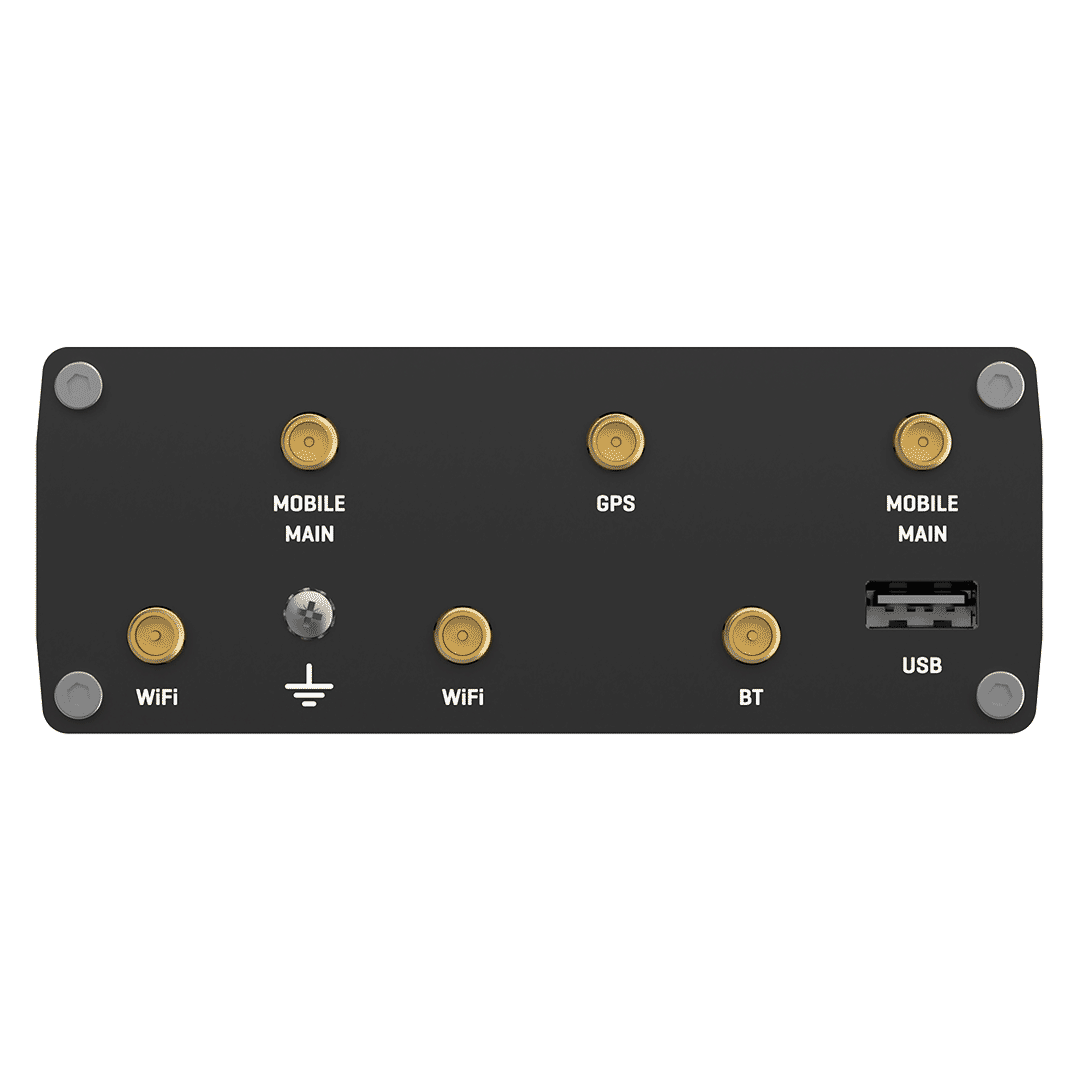




Tekniska specifikationer
Mobile
Cellular module: 4G LTE Cat 6 up to 300 Mbit/s download / 50 Mbit/s upload; 3G up to 42 Mbit/s download / 5.76 Mbit/s upload
3GPP version: Release 12
SIM switching: 2 SIM cards, automatic switching when: weak signal, data limit, SMS limit, roaming, no network, network access denied, data connection failed, SIM idle
Status: IMSI, ICCID, operator, operator status, data connection status, network type, CA indicator, bandwidth, connected band, signal strength (RSSI), SINR, RSRP, RSRQ, EC/IO, RSCP, data sent/received, LAC, TAC, cell ID, ARFCN, UARFCN, EARFCN, MCC and MNC
SMS: SMS status, SMS configuration, EMAIL to SMS, SMS to EMAIL, SMS to HTTP, SMS to SMS, scheduled SMS, SMS autoresponder, SMPP
USSD: Support for sending and reading USSD (Unstructured Supplementary Service Data) messages
Block/Allow List: Operator Block/Allow (by country or specific operators)
Multiple PDNs: Ability to use different PDNs for multiple network connections and services
Tape management: Tape locking, display of used tapes
SIM Sleep Protection: Provides the ability to configure the router to switch to the inactive SIM card and establish a data connection periodically to prevent the SIM card from being blocked
SIM PIN management: Allows you to set, change, or disable the SIM card PIN
APN: Automatic APN
Bridge: Direct connection (bridge) between mobile operator and device in LAN
Passthrough: The router assigns its mobile WAN IP address to another device on the LAN
3GPP version: Release 12
SIM switching: 2 SIM cards, automatic switching when: weak signal, data limit, SMS limit, roaming, no network, network access denied, data connection failed, SIM idle
Status: IMSI, ICCID, operator, operator status, data connection status, network type, CA indicator, bandwidth, connected band, signal strength (RSSI), SINR, RSRP, RSRQ, EC/IO, RSCP, data sent/received, LAC, TAC, cell ID, ARFCN, UARFCN, EARFCN, MCC and MNC
SMS: SMS status, SMS configuration, EMAIL to SMS, SMS to EMAIL, SMS to HTTP, SMS to SMS, scheduled SMS, SMS autoresponder, SMPP
USSD: Support for sending and reading USSD (Unstructured Supplementary Service Data) messages
Block/Allow List: Operator Block/Allow (by country or specific operators)
Multiple PDNs: Ability to use different PDNs for multiple network connections and services
Tape management: Tape locking, display of used tapes
SIM Sleep Protection: Provides the ability to configure the router to switch to the inactive SIM card and establish a data connection periodically to prevent the SIM card from being blocked
SIM PIN management: Allows you to set, change, or disable the SIM card PIN
APN: Automatic APN
Bridge: Direct connection (bridge) between mobile operator and device in LAN
Passthrough: The router assigns its mobile WAN IP address to another device on the LAN
Wireless
Wireless mode: 802.11b/g/n/ac Wave 2 (Wi-Fi 5) with data rates up to 867 Mbps (Dual Band, MU-MIMO), 802.11r fast transition, Access Point (AP), Station (STA)
Wi-Fi Security: WPA2-Enterprise: PEAP, WPA2-PSK, WPA-EAP, WPA-PSK, WPA3-SAE, WPA3-EAP, OWE; AES-CCMP, TKIP, automatic encryption method, client isolation, EAP-TLS with PKCS#12 certificate, disable auto-reconnect, 802.11w Protected Management Frames (PMF)
SSID/ESSID: ESSID stealth mode
Wi-Fi users: Up to 150 simultaneous connections
Wireless connectivity features: Wireless mesh (802.11s), fast roaming (802.11r), Relayd, BSS transition management (802.11v), radio source metering (802.11k)
Wi-Fi MAC Filter: Allow List, Block List
QR code generator for Wi-Fi: When the code is scanned, the user automatically connects to the network without having to enter login details
TravelMate: Forwards the Wi-Fi hotspot login page to the next connected device
Wi-Fi Security: WPA2-Enterprise: PEAP, WPA2-PSK, WPA-EAP, WPA-PSK, WPA3-SAE, WPA3-EAP, OWE; AES-CCMP, TKIP, automatic encryption method, client isolation, EAP-TLS with PKCS#12 certificate, disable auto-reconnect, 802.11w Protected Management Frames (PMF)
SSID/ESSID: ESSID stealth mode
Wi-Fi users: Up to 150 simultaneous connections
Wireless connectivity features: Wireless mesh (802.11s), fast roaming (802.11r), Relayd, BSS transition management (802.11v), radio source metering (802.11k)
Wi-Fi MAC Filter: Allow List, Block List
QR code generator for Wi-Fi: When the code is scanned, the user automatically connects to the network without having to enter login details
TravelMate: Forwards the Wi-Fi hotspot login page to the next connected device
Bluetooth
Bluetooth 4.0: Bluetooth Low Energy (LE) for short-range communication
Ethernet
WAN: 1 x WAN port, 10/100/1000 Mbps, compliant with IEEE 802.3, IEEE 802.3u, 802.3az standards, supports auto MDI/MDIX crossover
LAN: 3 x LAN ports, 10/100/1000 Mbps, compatible with IEEE 802.3, IEEE 802.3u, 802.3az standards, supports auto MDI/MDIX crossover
LAN: 3 x LAN ports, 10/100/1000 Mbps, compatible with IEEE 802.3, IEEE 802.3u, 802.3az standards, supports auto MDI/MDIX crossover
Network
Routing: Static routing, dynamic routing (BGP, OSPF v2, RIP v1/v2, EIGRP, NHRP), policy-based routing
Network protocols: TCP, UDP, IPv4, IPv6, ICMP, NTP, DNS, HTTP, HTTPS, SFTP, FTP, SMTP, SSL/TLS, ARP, VRRP, PPP, PPPoE, UPNP, SSH, DHCP, Telnet, SMPP, SNMP, MQTT, Wake On LAN (WOL), VXLAN
VoIP passthrough support: H.323 and SIP-ALG NAT aids in proper routing of VoIP packets
Connection Monitoring: Ping Reboot, Wget Reboot, Periodic Reboot, LCP and ICMP for Link Auditing
Firewall: Port forwarding, traffic rules, custom rules, TTL target customization
Firewall Status Page: View all firewall statistics, rules, and rule counters
Port Management: View the device's ports, enable and disable them, turn on/off auto-configuration, change the transmission speed, etc.
Network topology: Visual representation of your network, showing which devices are connected to which
Hotspot: Captive portal (hotspot), internal/external Radius server, Radius MAC authentication, SMS authorization, SSO authentication, internal/external landing page, walled garden, user scripts, URL parameters, user groups, individual restrictions for users or groups, user management, 9 predefined customizable themes and the ability to upload/download your own hotspot themes
DHCP: Static and dynamic IP assignment, DHCP relay, DHCP server configuration, status, static leases: MAC with wildcards
QoS / Smart Queue Management (SQM): Prioritization of traffic by source/destination, service, protocol or port, WMM, 802.11e
DDNS: Support for over 25 service providers, others can be configured manually
DNS over HTTPS: DNS-over-HTTPS proxy enables secure DNS resolution by routing DNS requests over HTTPS
Network backup: Wi-Fi WAN, cellular, VRRP, wired options – all can be used as automatic failover
Load Balancing: Balances internet traffic across multiple WAN connections
SSHFS: Ability to mount remote file systems via SSH protocol
VRF Support: Initial support for Virtual Routing and Forwarding (VRF)
Traffic Management: Real-time monitoring, wireless signal maps, traffic usage history
Network protocols: TCP, UDP, IPv4, IPv6, ICMP, NTP, DNS, HTTP, HTTPS, SFTP, FTP, SMTP, SSL/TLS, ARP, VRRP, PPP, PPPoE, UPNP, SSH, DHCP, Telnet, SMPP, SNMP, MQTT, Wake On LAN (WOL), VXLAN
VoIP passthrough support: H.323 and SIP-ALG NAT aids in proper routing of VoIP packets
Connection Monitoring: Ping Reboot, Wget Reboot, Periodic Reboot, LCP and ICMP for Link Auditing
Firewall: Port forwarding, traffic rules, custom rules, TTL target customization
Firewall Status Page: View all firewall statistics, rules, and rule counters
Port Management: View the device's ports, enable and disable them, turn on/off auto-configuration, change the transmission speed, etc.
Network topology: Visual representation of your network, showing which devices are connected to which
Hotspot: Captive portal (hotspot), internal/external Radius server, Radius MAC authentication, SMS authorization, SSO authentication, internal/external landing page, walled garden, user scripts, URL parameters, user groups, individual restrictions for users or groups, user management, 9 predefined customizable themes and the ability to upload/download your own hotspot themes
DHCP: Static and dynamic IP assignment, DHCP relay, DHCP server configuration, status, static leases: MAC with wildcards
QoS / Smart Queue Management (SQM): Prioritization of traffic by source/destination, service, protocol or port, WMM, 802.11e
DDNS: Support for over 25 service providers, others can be configured manually
DNS over HTTPS: DNS-over-HTTPS proxy enables secure DNS resolution by routing DNS requests over HTTPS
Network backup: Wi-Fi WAN, cellular, VRRP, wired options – all can be used as automatic failover
Load Balancing: Balances internet traffic across multiple WAN connections
SSHFS: Ability to mount remote file systems via SSH protocol
VRF Support: Initial support for Virtual Routing and Forwarding (VRF)
Traffic Management: Real-time monitoring, wireless signal maps, traffic usage history
Security
802.1x: Port-based network access control client
Authentication: Distributed key, digital certificates, X.509 certificates, TACACS+, internal and external RADIUS user authentication, IP and login attempt blocking, time-based login blocking, built-in random password generator
Firewall: Pre-configured firewall rules can be enabled via WebUI, unlimited firewall configuration via CLI, DMZ, NAT, NAT-T, NAT64
Attack protection: DDOS protection (SYN flood, SSH attacks, HTTP/HTTPS attacks), port scan protection (SYN-FIN, SYN-RST, X-mas, NULL flags, FIN scans)
VLAN: Port and tag-based VLAN separation
Mobile quota control: Mobile data limit, customizable period, start time, warning limit, phone number
Web filter: Blacklist to block unwanted websites, whitelist to only allow specific websites
Access Control: Flexible access control of SSH, web interface, CLI and Telnet
SSL Certificate Generation: Let's Encrypt and SCEP Certificate Generation Methods
Authentication: Distributed key, digital certificates, X.509 certificates, TACACS+, internal and external RADIUS user authentication, IP and login attempt blocking, time-based login blocking, built-in random password generator
Firewall: Pre-configured firewall rules can be enabled via WebUI, unlimited firewall configuration via CLI, DMZ, NAT, NAT-T, NAT64
Attack protection: DDOS protection (SYN flood, SSH attacks, HTTP/HTTPS attacks), port scan protection (SYN-FIN, SYN-RST, X-mas, NULL flags, FIN scans)
VLAN: Port and tag-based VLAN separation
Mobile quota control: Mobile data limit, customizable period, start time, warning limit, phone number
Web filter: Blacklist to block unwanted websites, whitelist to only allow specific websites
Access Control: Flexible access control of SSH, web interface, CLI and Telnet
SSL Certificate Generation: Let's Encrypt and SCEP Certificate Generation Methods
VPN
OpenVPN: Multiple clients and one server can run simultaneously, 27 encryption methods
OpenVPN encryption: DES-CBC 64, RC2-CBC 128, DES-EDE-CBC 128, DES-EDE3-CBC 192, DESX-CBC 192, BF-CBC 128, RC2-40-CBC 40, CAST5-CBC 128, RC2-64-CBC 64, AES-128-CBC 128, AES-128-CFB 128, AES-128-CFB1 128, AES-128-CFB8 128, AES-128-OFB 128, AES-128-GCM 128, AES-192-CFB 192, AES-192-CFB1 192, AES-192-CFB8 192, AES-192-OFB 192, AES-192-CBC 192, AES-192-GCM 192, AES-256-GCM 256, AES-256-CFB 256, AES-256-CFB1 256, AES-256-CFB8 256, AES-256-OFB 256, AES-256-CBC 256
IPsec: XFRM, IKEv1, IKEv2 with 14 IPsec encryption methods (3DES, DES, AES128, AES192, AES256, AES128GCM8, AES192GCM8, AES256GCM8, AES128GCM12, AES192GCM12, AES256GCM12, AES128GCM16, AES192GCM16, AES256GCM16)
GRE: GRE tunnel, GRE tunnel over IPsec support
PPTP, L2TP: Client/server instances can run simultaneously, support for L2TPv3, L2TP over IPsec
Stunnel: Proxy designed to add TLS encryption to existing clients and servers without changes to the application's code
DMVPN: Method for building scalable IPsec VPNs, supporting Phase 2, Phase 3 and Dual Hub
SSTP: SSTP client instance support
ZeroTier: ZeroTier VPN client support
WireGuard: Support for WireGuard VPN client and server
Tinc: Tinc offers encryption, authentication, and compression in its tunnels. Client and server support
Tailscale: Tailscale offers speed, stability, and simplicity over traditional VPN solutions. Encrypted point-to-point connections using the open WireGuard protocol
OpenVPN encryption: DES-CBC 64, RC2-CBC 128, DES-EDE-CBC 128, DES-EDE3-CBC 192, DESX-CBC 192, BF-CBC 128, RC2-40-CBC 40, CAST5-CBC 128, RC2-64-CBC 64, AES-128-CBC 128, AES-128-CFB 128, AES-128-CFB1 128, AES-128-CFB8 128, AES-128-OFB 128, AES-128-GCM 128, AES-192-CFB 192, AES-192-CFB1 192, AES-192-CFB8 192, AES-192-OFB 192, AES-192-CBC 192, AES-192-GCM 192, AES-256-GCM 256, AES-256-CFB 256, AES-256-CFB1 256, AES-256-CFB8 256, AES-256-OFB 256, AES-256-CBC 256
IPsec: XFRM, IKEv1, IKEv2 with 14 IPsec encryption methods (3DES, DES, AES128, AES192, AES256, AES128GCM8, AES192GCM8, AES256GCM8, AES128GCM12, AES192GCM12, AES256GCM12, AES128GCM16, AES192GCM16, AES256GCM16)
GRE: GRE tunnel, GRE tunnel over IPsec support
PPTP, L2TP: Client/server instances can run simultaneously, support for L2TPv3, L2TP over IPsec
Stunnel: Proxy designed to add TLS encryption to existing clients and servers without changes to the application's code
DMVPN: Method for building scalable IPsec VPNs, supporting Phase 2, Phase 3 and Dual Hub
SSTP: SSTP client instance support
ZeroTier: ZeroTier VPN client support
WireGuard: Support for WireGuard VPN client and server
Tinc: Tinc offers encryption, authentication, and compression in its tunnels. Client and server support
Tailscale: Tailscale offers speed, stability, and simplicity over traditional VPN solutions. Encrypted point-to-point connections using the open WireGuard protocol
OPC UA:
Supported modes: Client, Server
Supported connection types: TCP
Supported connection types: TCP
Modbus
Supported modes: Server, Client
Supported connection types: TCP, USB
Custom registers: MODBUS TCP custom register block requests that read/write to a file in the router and can be used to extend the functionality of the MODBUS TCP client
Supported data formats: 8-bit: INT, UINT 16-bit: INT, UINT (MSB or LSB first) 32-bit: float, INT, UINT (ABCD (big-endian), DCBA (little-endian), CDAB, BADC), HEX, ASCII
Supported connection types: TCP, USB
Custom registers: MODBUS TCP custom register block requests that read/write to a file in the router and can be used to extend the functionality of the MODBUS TCP client
Supported data formats: 8-bit: INT, UINT 16-bit: INT, UINT (MSB or LSB first) 32-bit: float, INT, UINT (ABCD (big-endian), DCBA (little-endian), CDAB, BADC), HEX, ASCII
Data to server
Protocol: HTTP(S), MQTT, Azure MQTT
Data to Server: Extract parameters from multiple sources and different protocols and send them all to a single server; Custom LUA scripting that allows scripts to leverage the router's functionality
Data to Server: Extract parameters from multiple sources and different protocols and send them all to a single server; Custom LUA scripting that allows scripts to leverage the router's functionality
MQTT Gateway
Modbus MQTT Gateway: Allows sending commands and receiving data from MODBUS server via MQTT broker
DNP3:
Supported modes: Station, Outstation
Supported connection: TCP, USB
Supported connection: TCP, USB
DLMS/COSEM
DLMS support: DLMS – standard protocol for exchanging meter data
Supported modes: Client
Supported connection types: TCP, USB
COSEM: Ability to scan the meter's COSEM object for automatic detection and configuration
Supported modes: Client
Supported connection types: TCP, USB
COSEM: Ability to scan the meter's COSEM object for automatic detection and configuration
API
Teltonika Networks Web API (beta) support: Extend your device's capabilities by using a set of configurable API endpoints to retrieve or modify data. For more information, please see this documentation: https://developers.teltonika-networks.com
Monitoring
WEB UI: HTTP/HTTPS, status, configuration, FW update, CLI, troubleshooting, multiple event log servers, notifications about available firmware updates, event log, system log, kernel log, internet status
FOTA: Firmware update from server, automatic notification
SSH: SSH (v1, v2)
SMS: SMS status, SMS configuration
Calls: Restart, status, mobile data on/off, output on/off, answer/hang up with timer, Wi-Fi on/off
TR-069: OpenACS, EasyCwmp, ACSLite, tGem, LibreACS, GenieACS, FreeACS, LibCWMP, Friendly tech, AVSystem
MQTT: MQTT Broker, MQTT publisher
SNMP: SNMP (v1, v2, v3), SNMP Trap, brute force protection
JSON-RPC: Management API over HTTP/HTTPS
RMS: Teltonika Remote Management System (RMS)
FOTA: Firmware update from server, automatic notification
SSH: SSH (v1, v2)
SMS: SMS status, SMS configuration
Calls: Restart, status, mobile data on/off, output on/off, answer/hang up with timer, Wi-Fi on/off
TR-069: OpenACS, EasyCwmp, ACSLite, tGem, LibreACS, GenieACS, FreeACS, LibCWMP, Friendly tech, AVSystem
MQTT: MQTT Broker, MQTT publisher
SNMP: SNMP (v1, v2, v3), SNMP Trap, brute force protection
JSON-RPC: Management API over HTTP/HTTPS
RMS: Teltonika Remote Management System (RMS)
IoT Platforms
ThingWorx: Allows monitoring of: WAN type, WAN IP, mobile carrier name, mobile signal strength, mobile network type
Cumulocity - Cloud of Things: Allows monitoring of: device model, revision and serial number, WAN type and IP, mobile cell ID, ICCID, IMEI, connection type, operator, signal strength. Has reboot and firmware upgrade capabilities
Azure IoT Hub: Can be configured with Data to Server to send all available parameters to the cloud. Supports Direct method which allows RutOS API calls to be executed on IoT Hub. Also has Plug and Play integration with Device Provisioning Service which enables automatic device provisioning (zero-touch) to IoT Hub
AWS IoT Core: Tools for interacting with the AWS cloud platform. Jobs support: call the device API with AWS Jobs functionality
Cumulocity - Cloud of Things: Allows monitoring of: device model, revision and serial number, WAN type and IP, mobile cell ID, ICCID, IMEI, connection type, operator, signal strength. Has reboot and firmware upgrade capabilities
Azure IoT Hub: Can be configured with Data to Server to send all available parameters to the cloud. Supports Direct method which allows RutOS API calls to be executed on IoT Hub. Also has Plug and Play integration with Device Provisioning Service which enables automatic device provisioning (zero-touch) to IoT Hub
AWS IoT Core: Tools for interacting with the AWS cloud platform. Jobs support: call the device API with AWS Jobs functionality
System properties
CPU: Quad-core ARM Cortex A7, 717 MHz
RAM: 256MB, DDR3
FLASH storage: 256 MB, SPI Flash
RAM: 256MB, DDR3
FLASH storage: 256 MB, SPI Flash
Firmware configuration
WEB UI: Update firmware from file, check firmware on server, configuration profiles, configuration backup
FOTA: Update firmware
RMS: Update firmware/configuration for multiple devices at once
Keep settings: Update firmware without losing current configuration
Factory Reset: A full factory reset will restore all system settings, including IP address, PIN, and user data to the manufacturer's default configuration.
FOTA: Update firmware
RMS: Update firmware/configuration for multiple devices at once
Keep settings: Update firmware without losing current configuration
Factory Reset: A full factory reset will restore all system settings, including IP address, PIN, and user data to the manufacturer's default configuration.
Firmware customization
Operating system: RutOS (OpenWrt-based Linux OS)
Supported languages: Busybox shell, Lua, C, C++, Python, Java via package manager
Development tools: SDK package with build environment provided
GPL Customization: You can create your own customized, branded firmware and web application by changing colors, logos, and other elements of our firmware to suit your or your customers' needs
Package Manager: The package manager is a service used to install additional software on the device
Supported languages: Busybox shell, Lua, C, C++, Python, Java via package manager
Development tools: SDK package with build environment provided
GPL Customization: You can create your own customized, branded firmware and web application by changing colors, logos, and other elements of our firmware to suit your or your customers' needs
Package Manager: The package manager is a service used to install additional software on the device
Location follow-up
GNSS: GPS, GLONASS, BeiDou, Galileo and QZSS
Coordinates: GNSS coordinates via WebUI, SMS, TAVL, RMS
NMEA: NMEA 0183
NTRIP: Networked Transport of RTCM via Internet Protocol (NTRIP) protocol
Server software: Supported server software TAVL, RMS
Geofencing: Configurable multiple geofence zones
Coordinates: GNSS coordinates via WebUI, SMS, TAVL, RMS
NMEA: NMEA 0183
NTRIP: Networked Transport of RTCM via Internet Protocol (NTRIP) protocol
Server software: Supported server software TAVL, RMS
Geofencing: Configurable multiple geofence zones
USB
Data speed: USB 2.0
Applications: Samba share, USB-to-serial
External devices: Ability to connect external hard drive, flash drive, additional modem, printer, USB serial adapter
File system support: FAT, FAT32, exFAT, NTFS (read only), ext2, ext3, ext4
Applications: Samba share, USB-to-serial
External devices: Ability to connect external hard drive, flash drive, additional modem, printer, USB serial adapter
File system support: FAT, FAT32, exFAT, NTFS (read only), ext2, ext3, ext4
Ingång/Utgång
Ingång: 1 x Digital ingång, 0–6 V registreras som logisk låg, 8–30 V registreras som logisk hög
Utgång: 1 x Digital utgång, Öppen kollektor, max utgång 30 V, 300 mA
Händelser: E-post, RMS, SMS
I/O-jonglör: Möjlighet att ställa in vissa I/O-villkor för att initiera händelser
Utgång: 1 x Digital utgång, Öppen kollektor, max utgång 30 V, 300 mA
Händelser: E-post, RMS, SMS
I/O-jonglör: Möjlighet att ställa in vissa I/O-villkor för att initiera händelser
Current
Connector: 4-pin industrial connector for DC power
Input voltage range: 9 - 50 V DC, reverse polarity protection, overvoltage and transient protection
24 - 36 V DC for railway version of model RUTX11 020G00
PoE (passive): Ability to power the device via the LAN1 port, not compatible with IEEE802.3af, 802.3at and 802.3bt standards, Mode B, 9 - 50 V DC
Power consumption: Max 16 W
Input voltage range: 9 - 50 V DC, reverse polarity protection, overvoltage and transient protection
24 - 36 V DC for railway version of model RUTX11 020G00
PoE (passive): Ability to power the device via the LAN1 port, not compatible with IEEE802.3af, 802.3at and 802.3bt standards, Mode B, 9 - 50 V DC
Power consumption: Max 16 W
Physical interfaces
Ethernet: 4 x RJ45 ports, 10/100/1000 Mbps
I/O1 x digital input, 1 x digital output on 4-pin power connector
Status LEDs: 4 x WAN type LEDs, 2 x mobile connection type, 5 x mobile connection strength, 8 x LAN status, 1 x power, 2 x 2.4G and 5G Wi-Fi
SIM: 2 x SIM card slots (Mini SIM - 2FF), 1.8 V/3 V, external SIM card holders
Power: 1 x 4-pin power connector
Antenna: 2 x SMA for cellular, 2 x RP-SMA for Wi-Fi, 1 x RP-SMA for Bluetooth, 1 x SMA for GNSS
USB: 1 x USB A port for external devices
Reset: Button for restart, reset to user defaults or factory reset
Other: 1 x grounding screw
I/O1 x digital input, 1 x digital output on 4-pin power connector
Status LEDs: 4 x WAN type LEDs, 2 x mobile connection type, 5 x mobile connection strength, 8 x LAN status, 1 x power, 2 x 2.4G and 5G Wi-Fi
SIM: 2 x SIM card slots (Mini SIM - 2FF), 1.8 V/3 V, external SIM card holders
Power: 1 x 4-pin power connector
Antenna: 2 x SMA for cellular, 2 x RP-SMA for Wi-Fi, 1 x RP-SMA for Bluetooth, 1 x SMA for GNSS
USB: 1 x USB A port for external devices
Reset: Button for restart, reset to user defaults or factory reset
Other: 1 x grounding screw
Physical specifications
Housing material: Aluminum housing
Dimensions (W x H x D): 115 x 44.2 x 95.1 mm
Weight: 456g
Mounting options: DIN rail, wall mount, flat surface (all require additional mounting kit)
Dimensions (W x H x D): 115 x 44.2 x 95.1 mm
Weight: 456g
Mounting options: DIN rail, wall mount, flat surface (all require additional mounting kit)
Operating area
Operating temperature: -40°C to 75°C
Operating humidity: 10% to 90% (non-condensing)
Protection class: IP30
Operating humidity: 10% to 90% (non-condensing)
Protection class: IP30
Regulations & Type Approval
Regulatory: CE, UKCA, EAC, UCRF, CITC, ICASA, ANRT, FCC, IC, PTCRB, RCM, IMDA, SIRIM, NTC, E-mark, Railway, UL/CSA safety, CB
Carriers: AT&T, Verizon, T-Mobile, Deutsche Telekom AG
Vehicle: ECE R10 (E-mark)
Carriers: AT&T, Verizon, T-Mobile, Deutsche Telekom AG
Vehicle: ECE R10 (E-mark)
EMC
Standards: EN 55032:2015 + A11:2020, EN 55035:2017 + A11:2020, EN 301 489-1 V2.2.3
Draft EN 301 489-3 V2.1.2, EN 301 489-17 V3.2.4, Draft EN 301 489-19 V2.2.0, EN 301 489-52 V1.2.1
ESD: EN 61000-4-2:2009
Radiated immunity: EN IEC 61000-4-3:2006 + A1:2008 + A2:2010
EFT: EN 61000-4-4:2012
Surge immunity (AC power supply): EN 61000-4-5:2014 + A1:2017
Surge immunity (AC power line): EN 61000-4-5:2014 + A1:2017
CS: EN 61000-4-6:2014
DIP: EN 61000-4-11:2004
Draft EN 301 489-3 V2.1.2, EN 301 489-17 V3.2.4, Draft EN 301 489-19 V2.2.0, EN 301 489-52 V1.2.1
ESD: EN 61000-4-2:2009
Radiated immunity: EN IEC 61000-4-3:2006 + A1:2008 + A2:2010
EFT: EN 61000-4-4:2012
Surge immunity (AC power supply): EN 61000-4-5:2014 + A1:2017
Surge immunity (AC power line): EN 61000-4-5:2014 + A1:2017
CS: EN 61000-4-6:2014
DIP: EN 61000-4-11:2004
RF
Standards: EN 301 908-1 V15.1.1, EN 301 908-2 V13.1.1, EN 301 908-13 V13.1.1, EN 300 328 V2.2.2, EN 301 893 V2.1.1, EN 303 413 V1.2.1, EN 300 440 V2.2.1
Security
Standards: CE: EN 62368-1:2014 + A11:2017, EN IEC 62311:2020, EN 50665:2017, UL/CSA UL 62368-1 (3rd Ed., Rev. December 13, 2019), CAN/CSA C22.2 No. 62368-1:19 (3rd Ed., Rev. December 13, 2019) RCM: AS/NZS 60950.1:2015, CB: IEC 62368-1:2018
Garanti
2 års fabriksgaranti

300Mbps

Auto failover for maximum operational reliability

Wi-Fi & Bluetooth

With four Gigabit Ethernet ports
Do you want to know more about the product?
Contact us for a demo or if you have any questions.
